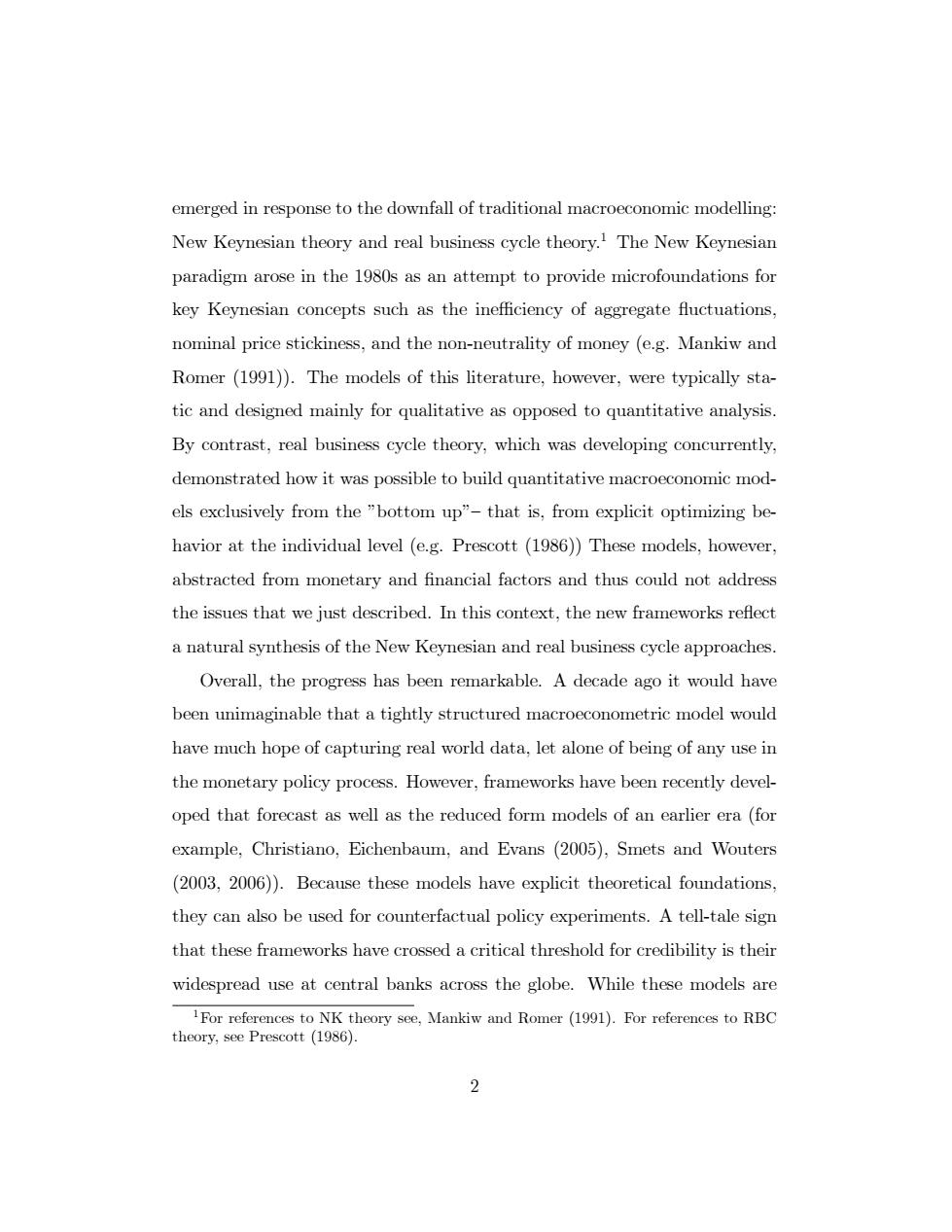正在加载图片...

emerged in response to the downfall of traditional macroeconomic modelling: New Keynesian theory and real business cycle theory.1 The New Keynesian paradigm arose in the 1980s as an attempt to provide microfoundations for key Keynesian concepts such as the inefficiency of aggregate fluctuations, nominal price stickiness,and the non-neutrality of money (e.g.Mankiw and Romer (1991)).The models of this literature,however,were typically sta- tic and designed mainly for qualitative as opposed to quantitative analysis. By contrast,real business cycle theory,which was developing concurrently, demonstrated how it was possible to build quantitative macroeconomic mod- els exclusively from the "bottom up"-that is,from explicit optimizing be- havior at the individual level (e.g.Prescott (1986))These models,however, abstracted from monetary and financial factors and thus could not address the issues that we just described.In this context,the new frameworks reflect a natural synthesis of the New Keynesian and real business cycle approaches. Overall,the progress has been remarkable.A decade ago it would have been unimaginable that a tightly structured macroeconometric model would have much hope of capturing real world data,let alone of being of any use in the monetary policy process.However,frameworks have been recently devel- oped that forecast as well as the reduced form models of an earlier era (for example,Christiano,Eichenbaum,and Evans (2005),Smets and Wouters (2003,2006)).Because these models have explicit theoretical foundations, they can also be used for counterfactual policy experiments.A tell-tale sign that these frameworks have crossed a critical threshold for credibility is their widespread use at central banks across the globe.While these models are 1For references to NK theory see,Mankiw and Romer(1991).For references to RBC theory,see Prescott (1986). 2emerged in response to the downfall of traditional macroeconomic modelling: New Keynesian theory and real business cycle theory.1 The New Keynesian paradigm arose in the 1980s as an attempt to provide microfoundations for key Keynesian concepts such as the ine¢ ciency of aggregate áuctuations, nominal price stickiness, and the non-neutrality of money (e.g. Mankiw and Romer (1991)). The models of this literature, however, were typically static and designed mainly for qualitative as opposed to quantitative analysis. By contrast, real business cycle theory, which was developing concurrently, demonstrated how it was possible to build quantitative macroeconomic models exclusively from the îbottom upîñ that is, from explicit optimizing behavior at the individual level (e.g. Prescott (1986)) These models, however, abstracted from monetary and Önancial factors and thus could not address the issues that we just described. In this context, the new frameworks reáect a natural synthesis of the New Keynesian and real business cycle approaches. Overall, the progress has been remarkable. A decade ago it would have been unimaginable that a tightly structured macroeconometric model would have much hope of capturing real world data, let alone of being of any use in the monetary policy process. However, frameworks have been recently developed that forecast as well as the reduced form models of an earlier era (for example, Christiano, Eichenbaum, and Evans (2005), Smets and Wouters (2003, 2006)). Because these models have explicit theoretical foundations, they can also be used for counterfactual policy experiments. A tell-tale sign that these frameworks have crossed a critical threshold for credibility is their widespread use at central banks across the globe. While these models are 1For references to NK theory see, Mankiw and Romer (1991). For references to RBC theory, see Prescott (1986). 2